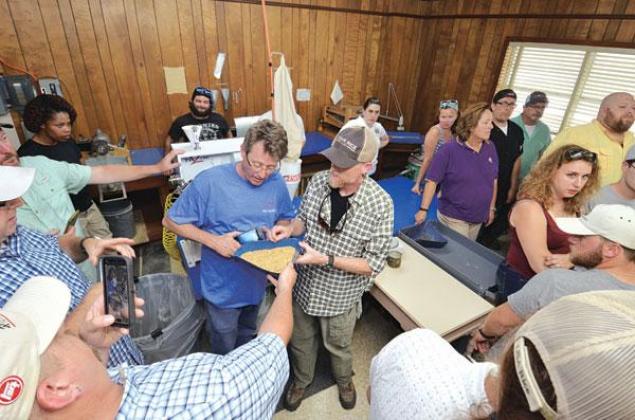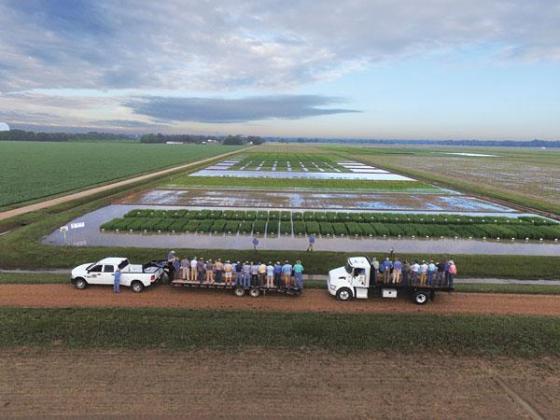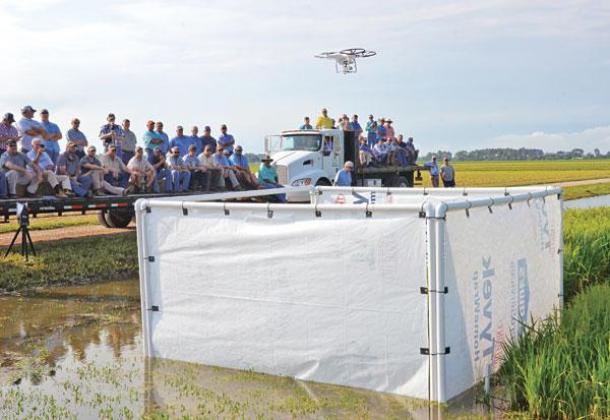


Bruce Schultz
More than 400 people attended the LSU AgCenter H. Rouse Caffey Rice Research Station field day on June 28 to hear about the latest work being done to help rice farmers.
During the field tour, Steve Linscombe, LSU AgCenter rice breeder and station director, said the new Provisia rice technology has taken five years to develop, with one line ready for release as a variety and three new lines in the works.
The Provisia system will help farmers fight weedy rice that cannot be controlled by Clearfield technology. “Having a different mode of action is certainly going to allow us to go in to these fields with weedy rice,” he said.
The current Provisia line expected to be released this year has exceptional grain quality, with low chalk and a long grain length exceeding 7 millimeters, he said.
A Clearfield Jazzman line could be released with higher yield potential and grain quality than its predecessors, along with improved aroma, he said.
AgCenter weed scientist Eric Webster said the Provisia lines grown this year have shown some signs of herbicide injury. “A lot of times, you don’t know what a product will do until you get it in the hands of growers,” he said.
Tank mixing Provisia herbicide with Grasp, propanil, Stam, Ricebeaux or Regiment is not recommended because those products could interfere with Provisia’s effectiveness on grasses, Webster said.
He advised using a pre-emergence herbicide or early post-emergence herbicides, such as Command or Sharpen, with Provisia.
AgCenter research associate Ben McKnight said two new herbicides should be released soon.
Loyant could be available next year for controlling grasses and sedges, and benzobicyclon, a good aquatic herbicide, could be released in 2019, he said.
AgCenter rice breeder Adam Famoso said a new DNA screening lab will improve the efficiency of the breeding and foundation seed program. The lab was assembled with funds allocated by the Louisiana Rice Research Board. “A setup like that would not be possible without their support,” he said.
The screening technology will catch variations in the foundation seed program before seed is planted in the field.
The system also will simplify developing a line of rice with a particular trait, he said, and do it more quickly and cheaply.
AgCenter plant pathologist Don Groth said farmers should consider only using fungicides if they are needed to get a good return on the investment of growing a crop. “If we manage fungicides correctly, we will continue to get a good return,” he said.
AgCenter plant pathologist Clayton Hollier announced he is retiring at the end of this year.
AgCenter entomologist and head of the AgCenter Department of Entomology Mike Stout said graduate students are studying different ways of controlling insects. In addition to using different pesticides, a project is underway to see if using a plant hormone on rice seed will provide natural resistance to rice water weevils. “It does seem to be working, to some extent,” he said.
Studies are also underway looking at using a fungus and a silicon soil amendment to impart resistance against weevils, Stout said.
AgCenter entomologist Blake Wilson said the first year of a study is showing that the edges of fields have the highest populations of rice water weevils.
Late-planted rice is at the greatest risk from a fly called the South American rice miner. It has been only a sporadic pest, so its effects on yields are not certain, Wilson said, but it has caused widespread problems
A strategy to control the South American rice miner is under development, he said.
AgCenter hybrid breeder Jim Oard said development of a rice hybrid continues successfully. Four new experimental lines with the Provisia traits are in the hybrid program.
Oard demonstrated pollination of hybrid rice plants with a drone piloted by research associate Brady Williams.
AgCenter rice extension specialist Dustin Harrell said nitrogen fertilizer can be lost to volatilization if it is applied to wet soil before flooding.
But a new urease inhibitor could be released next year that will reduce nitrogen losses even better than Agrotain. The new product will have an advantage on acidic soils, Harrell said.
Bobby Golden, rice specialist for Mississippi State University, said adding phosphorous to rice fields can boost yields by 585 pounds per acre in soil deficient in the element.
AgCenter economist Michael Deliberto said tightening world rice stocks could boost world market prices. He said rice acreage has declined this year for all Southern rice growing states, with Louisiana’s 400,000 acres reflecting a 9 percent decline from 2016.
Jennifer James, an Arkansas rice farmer and chairwoman of the USA Rice Sustainability Committee, said rice producers can inform consumers about the care taken by growers for the environment.
“You can speak to the water quality on your farm,” she said. “You can speak to the importance of habitat for wildlife.”
Mike Strain, commissioner of the Louisiana Department of Agriculture and Forestry, said he has told Scott Pruitt, secretary of the U.S. Environmental Protection Agency, that sustainable environmental safeguards are needed, but unnecessary regulations need to be eliminated. Strain said he told Sonny Perdue, secretary of the U.S. Department of Agriculture, that ports and inland waterways need improvements.
A proposal for the next farm bill includes elimination of the overseas market access program that benefits the rice industry with $4.5 million, Strain said.
Betsy Ward, chief executive officer of USA Rice, said the access market program has helped fight trade barriers and develop new markets. The money is used to obtain industry matching funds for market promotion.
“We have helped U.S. rice get a fair shot at tenders in Iraq, most recently leading to a 30,000-metric ton sale, and much of this rice will come from Louisiana,” Ward said.
Also in attendance at the field day were 54 chefs and staff members from restaurants in New Orleans and Baton Rouge. Jazzmen Rice of New Orleans organized the visit.
“It gives us a much better appreciation for everything,” said Matthew Pettus, chef-in-training with Dickie Brennan and Company.
The chefs were later given a milling demonstration at the station and heard about rice quality.
A half dozen staffers from the EPA also were at the field day as part of a tour organized by USA Rice to show environmental regulators what is involved in growing rice.
